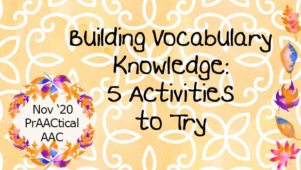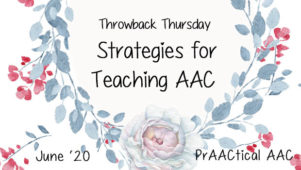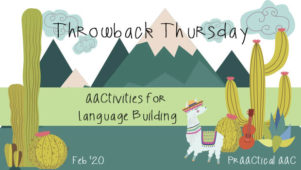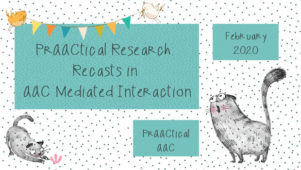AACtual Therapy: Supporting the Development of Early Grammar with Kimberly Ho
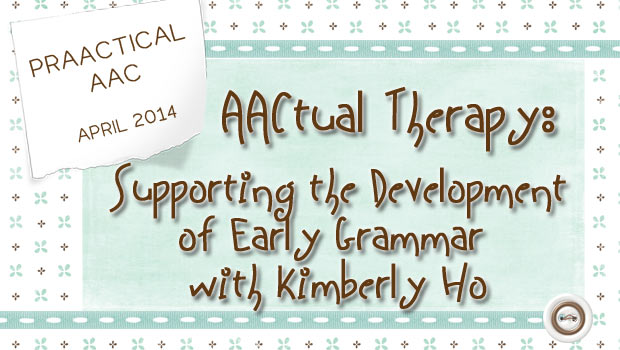
Our guest post for today is from SLP Kimberly Ho, an AAC specialist who operates a private practice, AAC Services. I met Dr. Ho many years ago when she was getting her master’s degree at Purdue University. She went on to get her doctorate and now consults for a number of public schools and works with individuals with AAC needs from preschoolers to adults. Kimberly is active in teaching (undergraduate and graduate courses), writing (published three articles in peer reviewed journals) and public speaking (15  presentations at regional, national and international conferences). In this post, she discusses some concepts in teaching grammar to people who are learning AAC.
presentations at regional, national and international conferences). In this post, she discusses some concepts in teaching grammar to people who are learning AAC.
Traditionally, individuals with complex communication needs (CCN) were provided with communication boards or speech generating devices (SGDs) filled with topic specific vocabulary often called fringe words. The field of AAC is only just beginning to provide early communicators with access to Core Vocabulary, the roughly 350 most frequently occurring words which makes up 80% of what we say (Vanderheiden & Kelso, 1987). Core vocabulary promotes the combination of words, an important precursor to developing syntax. Brown’s Five Stages of development provides a framework for understanding and promoting the development of grammar for individuals with CCN.
Most of us speech language pathologists (SLPs) learned about Brown’s Stages in graduate school, took the test, and promptly forgot it. (I know I did). We do have lists of when to teach certain syntax goals for our speaking children in therapy or on IEPs. So we DO know what to do with our kids who can talk, but give us a kid who uses AAC, and we’re stumped. We may get stuck on adding more and more nouns (fringe vocabulary) as nouns are easier to represent, teach and evaluate (Romski & Sevcik). There is often no room for morphemes like –ing, or plural and possessive /s/. Or if we want to start teaching these morphemes, we aren’t sure how to add them to the system.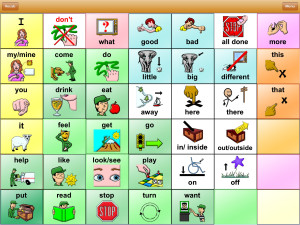
Instead of worrying about what we DON’T know about teaching AAC users grammar, let’s focus on what we DO know. We do know how to teach grammar to speaking children. So pull out your old text books and let’s go back to Brown:
In Brown’s stage one, the language user demonstrates understanding of semantic roles and syntactic relationships. For 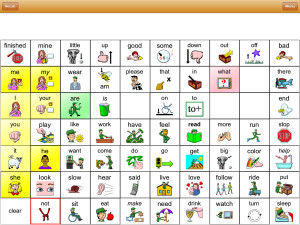 instance, an individual may combine core words to form the following utterances: “Mine!”, “Find it,” “See daddy,” and “Up here.” These are core words that are used by typically developing toddlers as seen in the Banajee study (2003). When we as educators and therapists provide our early communicators with these vocabulary words used by typically developing toddlers, the learner has the wherewithal to begin to combine words and take the first steps in grammatical development. Once the mean length of utterance (MLU) is 1.0 to 2.0 , the child typically has a corpus of at least 50 words and begins to combine words. This occurs with typically developing children between 15 and 30 months
instance, an individual may combine core words to form the following utterances: “Mine!”, “Find it,” “See daddy,” and “Up here.” These are core words that are used by typically developing toddlers as seen in the Banajee study (2003). When we as educators and therapists provide our early communicators with these vocabulary words used by typically developing toddlers, the learner has the wherewithal to begin to combine words and take the first steps in grammatical development. Once the mean length of utterance (MLU) is 1.0 to 2.0 , the child typically has a corpus of at least 50 words and begins to combine words. This occurs with typically developing children between 15 and 30 months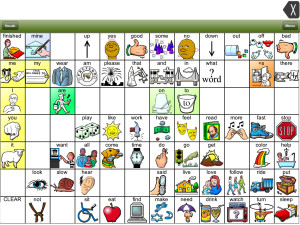
So for our AAC users, we need to make sure they have access to core vocabulary. A page full of nouns like cookie and car doesn’t promote word combination. What sense does “cookie car” make? If we include words that toddlers actually say like it and that on AAC systems, and model the combination of these words using aided language stimulation, our AAC users WILL start to combine. I have found this to be the case with students with moderate to severe intellectual impairments and students with autism again and again in my practice.
Brown’s Stage two is where more grammatical morphemes are introduced, which are the smallest units of meaning. Morphemes include the present progressive –ing, past tense –ed, plural /s/, possessive /’s/ and prepositions in and on. For instance, “That’s daddy.” Typically developing children begin to use these morphemes from age 28 months to 36 months when the MLU is between 2.0 and 2.5.
An individual with an AAC system who is ready for this stage must have access to these morphemes in their device. But how often do we see –ing or –ed on an SGD for a user who is using two to three word utterances (i.e., MLU of 2.75)? Word Power® and Picture Word Power® are now being offered on several platforms, but there are limitations to this system. They require reading and many of our AAC users are not literate. There are single meaning symbols to represent some core words, but many are represented by the word 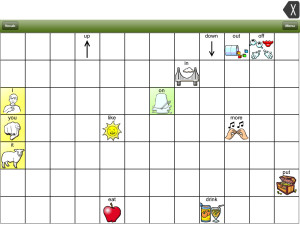 alone. When the user constructs a sentence (assuming they are literate and can find the words they need), then the morphemes change location based on what page the user is on. (Or a pop up may be used on another system for morphemes). In Word Power and with pop up windows, the user is required to visually scan to find the morphemes. So it seems possible but not easy to construct grammatically correct utterances with these page based systems, but how do you teach these morphemes if they are moving all over the place? And how do we teach them when we are using single meaning symbols or words to represent the morphemes.
alone. When the user constructs a sentence (assuming they are literate and can find the words they need), then the morphemes change location based on what page the user is on. (Or a pop up may be used on another system for morphemes). In Word Power and with pop up windows, the user is required to visually scan to find the morphemes. So it seems possible but not easy to construct grammatically correct utterances with these page based systems, but how do you teach these morphemes if they are moving all over the place? And how do we teach them when we are using single meaning symbols or words to represent the morphemes.
Stage three introduces the modalities of simple sentence structure and includes yes/no questions, WH questions, negatives, imperatives, and the introduction of auxiliary or helping verbs (can, do). Examples include, “Who this?” and “I don’t.” This stage typically emerges at 36 to 42 months, when the speaker is using a MLU of 2.5 to 3.0. “What” is typically the only question provided on SGDs, if questions are provided at all. Further, “not” and “don’t” are often absent so negatives cannot be modeled.
Since we know natural speakers begin using questions at a really young age (two to three), we need to make sure we include questions on the AAC system.
In Stage four, the speaker learns to imbed one sentence within another. Articles a and the appear, along with regular past tense and the third person regular present. Negatives are ![]() used with auxiliary verbs. The speaker changes word order using inversion to ask a question. For instance, the speaker may produce, “Isn’t it?” This is typically seen from 40 months to 46 months when an MLU of 3.0 to 3.7 is reached.
used with auxiliary verbs. The speaker changes word order using inversion to ask a question. For instance, the speaker may produce, “Isn’t it?” This is typically seen from 40 months to 46 months when an MLU of 3.0 to 3.7 is reached.
Finally, stage five includes the coordination of simple sentences and propositional relations. Indirect objects are used with subjects and auxiliary verbs. Speakers use 3rd person irregular, indirect objects, and the contractible copula. The speaker may say, “Wouldn’t you?” It occurs from 42 months to 52 months at an MLU of 3.7 to 4.5.
Typically developing children attain complex syntax at a very early age. We can use their developmental process to guide us in providing AAC systems and in our intervention for individuals with CCN. We need to provide the words and morpheme used by young children in their AAC systems and model their use. When we really think about it, we find that we really DO know how to teach this stuff – we learned it all in grad school and do so with our speaking students. We just need to make sure core vocabulary and morphemes are provided on the AAC systems.
:::::::::::::::::::::::::::::::::::::::::::::::::::::::
Banajee, M., Dicarlo, C., & Suras Stricklin, S. (2003). Core Vocabulary Determination for Toddlers. Augmentative and Alternative Communication, 67-73.
Brown, R. (1973). A first language: The early stages. London: George Allen & Unwin.
Vanderheiden, G. C, and Kelso, D. P. (1987). Comparative analysis of fixed-vocabulary communication acceleration techniques. Augmentative and Alternative Communication, 3, 196-206.
Filed under: PrAACtical Thinking
Tagged With: Brown's stages, grammar, Kimberly Ho, language intervention
This post was written by Carole Zangari

